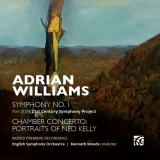Wenn man das titelgebende Zitat von Yehudi Menuhin zu diesem 1956 geborenen britischen Komponisten liest, weiß man nicht so genau, ob man sich abschrecken lassen soll oder nicht, die Musik anzuhören. Diese Ersteinspielungen sind dann, so viel sei schon verraten, spannend und neu in ihrer Sprache, also anregend und wert, wahrgenommen zu werden. Sie sind nicht erschreckend, zumal die Tonalität nicht auch noch große Kapriolen schlägt und in dieser Hinsicht das Ohr nicht überanstrengt wird. Dazu mag auch beitragen, dass Lyrismus und Zugänglichkeit dem Komponisten bis heute wichtig sind. « Es geht mir darum, dass meine Musik die Menschen berührt. Ich schreibe für ein Publikum. »
Die Symphonie zeigt in Dauer, dreiviertel Stunde, und Form, vier Sätze, zunächst ein klassisches Bild und stellt damit eine zeitgenössische Fortschreibung dieses Formentyps dar. Zwischen 2018 und 2021 entstanden, wird in ihr den Streichern die Aufgabe zuteil, voller Energie das Werk zu eröffnen. Im weiteren Verlauf des ersten Satzes sind dann ruhigere Abschnitte zu hören, die aber mit Unruhe untermalt sind, die erst am Ende die Oberhand gewinnt. Das folgende Scherzando ist ganz typgerecht schnell und spielerisch, was technisches Können erfordert. Mit solistischer Klarinette sowie weitgefassten Aufgaben für die Bläser und das Schlagzeug beweist Adrian Williams, dass er es versteht, ausgezeichnet zu orchestrieren.
Der langsame Satz ist als Klagegesang formuliert. Damit reagiert Williams emotional auf die verheerenden Buschbrände in Australien. Angst und Schock bilden die eine Seite, Momente großer Nachdenklichkeit und Stille die andere. Der letzte Satz, der mehr als ein Drittel des Werkes ausmacht, wird tief grollend durch Bässe, Kontrafagott und tiefe Blechbläser eröffnet, bis sich das ganze Orchester energisch einmischt. Es folgen zarte Soli von Violine und Flöte, bis wieder leidenschaftlichere Momente erklingen. Über Spannungs- und Entlastungselemente steigert sich die Musik dann sozusagen stilecht zum dramatischen Ende.
Das Kammerkonzert ‘Porträts von Ned Kelly’ für elf Musiker ist von den Gemälden von Sidney Nolan inspiriert, der den australischen Outlaw und Bushranger Ned Kelly malte. Dieses brillante und virtuose Werk mag wie ein moderner Till Eulenspiegel klingen, der unter Drogeneinfluss steht. Es ist witzig, surreal und irgendwie auch bewegend.
In seiner Zeit als Composer in Association beim English Symphony Orchestra entstand die Symphonie im Rahmen einer Reihe der Sinfonien des 21. Jahrhunderts des Orchesters. Das Orchester unter der Leitung seines Chefs Kenneth Woods kann sich bei den vielen eher kurzen Soli und daneben auch im gesamten Ensemble bestens präsentieren. Trotz der vielen Anforderungen an alle Beteiligten zeigen sich keine Schwächen. Das Orchester agiert ausgewogen und diszipliniert sowie mit der erforderlichen Intensität. Die Leitung durch Kenneth Woods führt zu einer klar strukturierten Darstellung, die mit Elan die Musik darbietet. Die Aufnahme ist klar und ausgewogen und sehr präsent, aber nicht aufdringlich.
When you read the titular quote from Yehudi Menuhin about this 1956-born British composer, you don’t really know whether or not to be deterred from listening to the music. These first recordings are then, let us say, exciting and new in their language, thus stimulating and worth being heard. They are not frightening, especially since the tonality does not also make great capers and in this respect the ear is not overstrained. It may also contribute to this that lyricism and accessibility are important to the composer to this day. « What matters to me is that my music touches people. I write for an audience. »
In duration, three-quarters of an hour, and form, four movements, the symphony initially presents a classical image and thus represents a contemporary continuation of this type of form. Written between 2018 and 2021, the strings are given the task of opening the work full of energy. As the first movement progresses, quieter sections can then be heard, but they are punctuated with restlessness that only takes over at the end. The Scherzando that follows is quite typically fast and playful, requiring technical skill. With solo clarinet as well as wide-ranging tasks for the winds and percussion, Adrian Williams proves that he knows how to orchestrate excellently.
The slow movement is a lament. With it, Williams reacts emotionally to the devastating bushfires in Australia. Fear and shock form one side, moments of great thoughtfulness and silence the other. The last movement, which makes up more than a third of the work, opens deeply rumbling by basses, contrabassoon and low brass until the full orchestra joins in energetically. Delicate solos by violin and flute follow until more passionate moments are heard again. Through elements of tension and relief, the music then rises, as it were in keeping with the style, to a dramatic ending.
The chamber concerto Portraits of Ned Kelly for eleven musicians is inspired by the paintings of Sidney Nolan, who painted the Australian outlaw and bushranger Ned Kelly. This brilliant and virtuosic work may sound like a modern day Till Eulenspiegel drugged out of his mind. It’s funny, surreal and somehow also moving.
During his time as composer in association with the English Symphony Orchestra, the symphony was written as part of a series of the orchestra’s 21st century symphonies. The orchestra, under the baton of its leader Kenneth Woods, is at its best in the many rather brief solos and besides that in the ensemble as a whole. Despite the many demands on all participants, no weaknesses show. The ensemble is balanced and disciplined and shows the necessary intensity. The direction by Kenneth Woods results in a clearly structured performance that presents the music with verve. The recording is clear and balanced and very present, but not obtrusive.






















